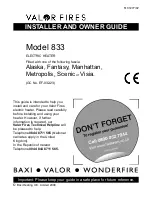
13
INSTALLATION REQUIREMENTS
GAS SUPPLY SYSTEMS
Low pressure building gas supply systems are defined as those
systems that cannot under any circumstances exceed 14”
W.C. (1/2 PSI Gauge). These systems do not require pressure
regulation. Measurements should be taken to insure that gas
pressures are stable and fall within the requirements stated on the
water heater rating plate. Readings should be taken with all gas
burning equipment off (static pressure) and with all gas burning
equipment running at maximum rate (dynamic pressure). The gas
supply pressure must be stable within 1.5” W.C. from static to
dynamic pressure to provide good performance. Pressure drops
that exceed 1.5” W.C. may cause rough starting, noisy combustion
or nuisance outages. Increases or spikes in static pressure during
off cycles may cause failure to ignite or in severe cases damage to
appliance gas valves. If your low pressure system does
NOT
meet
these requirements, the installer is responsible for the corrections.
High Pressure building supply systems use pressures that
exceed 14” W.C. (1/2 PSI Gauge). These systems must use field
supplied regulators to lower the gas pressure to less than 14”
W.C. (1/2 PSI Gauge). Water heaters require gas regulators that
are properly sized for the water heater input and deliver the rating
plate specified pressures. Gas supply systems where pressure
exceeds 5 PSI often require multiple regulators to achieve desired
pressures. Systems in excess of 5 PSI building pressure should
be designed by gas delivery professionals for best performance.
Water heaters connected to gas supply systems that exceed 14”
W.C. (1/2 PSI Gauge) at any time must be equipped with a gas
supply regulator.
All models require a minimum gas supply pressure of 3.5" W.C. for
natural gas and 8.5" W.C. for propane gas. The minimum supply
pressure is measured while gas is flowing (dynamic pressure).
The supply pressure should never fall below 3.5" W.C. for natural
gas and 8.5" W.C. for propane gas. The supply pressure should be
measured with all gas fired appliances connected to the common
main firing at full capacity. If the supply pressure drops more than
1.5” W.C. as gas begins to flow to the water heater then the supply
gas system including the gas line and/or the gas regulator may
be restricted or undersized. See
section of
this manual. The gas valve on all models has a maximum gas
supply pressure limit of 14” W.C. The maximum supply pressure
is measured while gas is not flowing (static pressure).
SUPPLY GAS REGULATOR
The maximum allowable gas supply pressure for this water
heater is 14.0 inches W.C. (3.49 kPa) for natural and propane
gas. Install a positive lock-up gas pressure regulator in the
gas supply line if inlet gas pressure can exceed these pres-
sures at any time.
If a positive lock-up regulator is required follow these instructions:
1.
Positive lock-up gas pressure regulators must be rated at or
above the input Btu/hr rating of the water heater they supply.
2.
Supply gas regulators shall have inlet and outlet connections
not less than the minimum supply gas line size for the water
heater they supply. See
3. Positive lock-up gas pressure regulator(s) should be installed
no closer than 3 feet (1 meter) and no farther than 8 feet (2.4
meters) from the water heater’s inlet gas connection.
4.
After installing the positive lock-up gas pressure regulator(s)
an initial nominal supply pressure setting of 7.0” W.C. while the
water heater is operating is recommended and will generally
provide good water heater operation. Some additional
adjustments may be required later to maintain a steady gas
supply pressure.
5.
When installing multiple water heaters in the same gas supply
system it is recommended that individual positive lock-up gas
pressure regulators be installed at each unit from the supply
gas connection on the water heater.
POWER SUPPLY
The water heaters covered in this manual require a 120 VAC,
1Ø (single phase), 60 Hz, 15 amp power supply and must also
be electrically grounded in accordance with local codes or, in the
absence of local codes, with the
National Electrical Code
,
ANSI/NFPA
70
or the
Canadian Electrical Code, CSA C22.1
.
DEDICATED POWER WIRING AND BREAKERS
Dedicated power supply wires, neutral wires, ground wiring, and
dedicated circuit breakers, often prevent electrical line noise and
are required when installing the water heater.
Note:
This water heater should not be connected to
an electrical supply with a Ground Fault Circuit
Interrupter (GFCI) or Arc Fault Circuit Interrupter
(AFCI) with Integral GFCI protection as defined in
NFPA 70
,
CSA C22.1
and
UL 943
.
POWER FLUCTUATIONS AND ELECTRICAL NOISE
The water heater’s control system requires a source of stable
clean electricity for proper operation. Connecting the water heater
to a branch circuit that is subject to fluctuations in voltage level or
electrical line noise such as EMI (electro magnetic interference)
or RFI (radio frequency interference) may cause erratic control
system operation and malfunction.
A high quality power supply filter/suppressor must be installed if the
above conditions exist. Call the technical support phone number
listed on the back cover of this manual or contact a local power
filter/suppressor supplier for more information.
Note:
Malfunctions caused by the power supply and costs to
install power supply filters are not covered under the
limited warranty. See
Summary of Contents for SUF 60120 THRU
Page 67: ...67 WIRING DIAGRAM Figure 67 Wiring Diagram...
Page 77: ...77 NOTES...
Page 78: ...78 NOTES...
Page 79: ...79 NOTES...














































